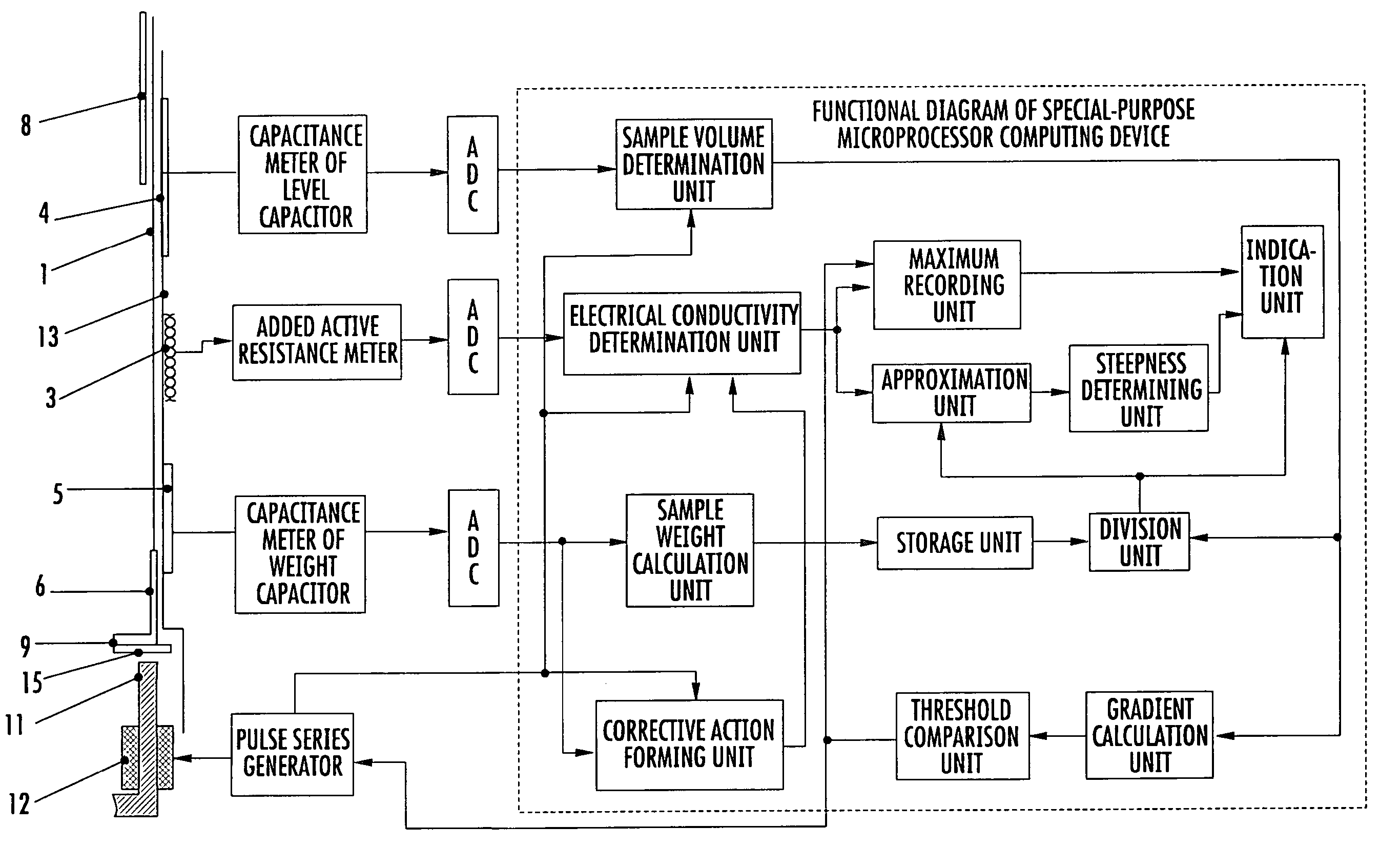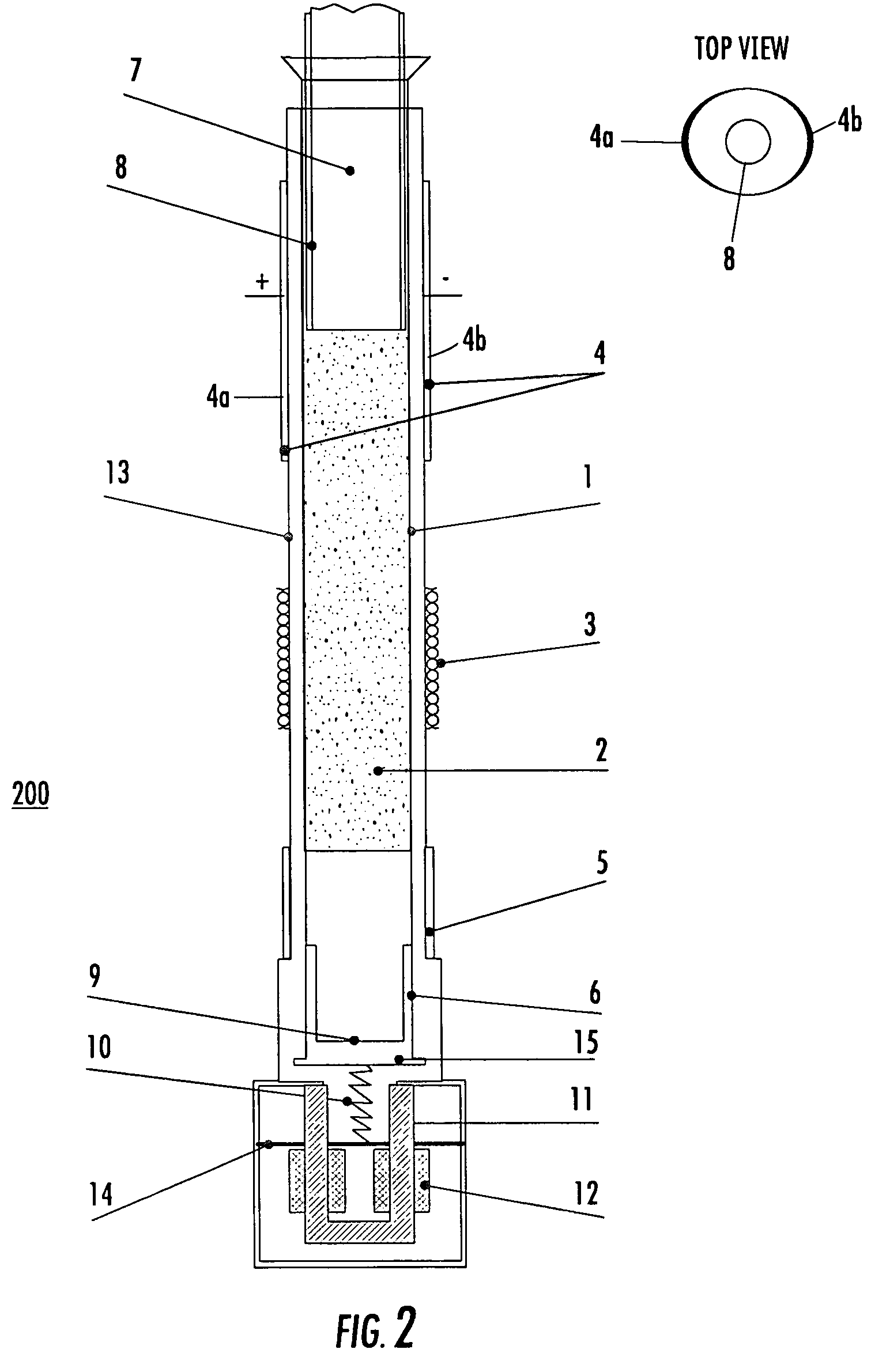Method and apparatus for measuring conductivity of powder materials using eddy currents
a technology of conductivity measurement and powder material, which is applied in the direction of instruments, specific gravity measurement, carbides, etc., can solve the problems of relatively small contact area and inability to accurately determine contact measurements
- Summary
- Abstract
- Description
- Claims
- Application Information
AI Technical Summary
Benefits of technology
Problems solved by technology
Method used
Image
Examples
example 1
[0149]The magnetic field of a circular coil with current I of radius R is first considered. It is known that the magnetic field intensity on the coil axis, that is at ρ=0 is determined by the formula:
[0150]Hz=I2R2[R2+z2]3 / 2,(11)
where ρ, z are coordinates of the cylindrical system of coordinates whose center is coincident with the center of the coil. The field intensity in the coil center.
[0151]Hz(z=0)=I2R.(12)
[0152]The relationships Hz / Hz(z=0) as a function of the coordinate z normal to the coil plane is now considered.
[0153]The respective values of relative intensity Hz / Hz(z=0) calculated according to formulas (11) and (12) as a function of the rated coordinate z / R are given in Table 1. According to Table 1 the magnetic field intensity at distance z along the coil axis equal to its diameter is 8.9% relative to the intensity value in the coil center.
[0154]
TABLE 1Hz / Hz(z = 0)z / R100.7150.50.3541.00.1711.50.0892.0
example 2
[0155]The formula for determining the capacitance per length unit (1 m) between infinitely long cylindrical casings of circular cross-section in case when one of the casings is arranged inside of the other (see FIG. 7) has the following form:
[0156]Cl=1m=2πɛ0ɛArchR12+R22-d22R1R2,(13)
where l is the coordinate along the cylinder generating line; ε is the dielectric permeability of the material between the cylindrical casings, R1 and R2 are the radiuses of the casings, d is the shift of the casing axes, ε=8.854*10−12 F / m is the dielectric constant of free space.
[0157]Value Arch x is Expressed as Follows:
y=Archx=ln(x−√{square root over (x2−1)}), for x≧1 and −∞
y=Archx=ln(x+√{square root over (x2−1)}), for x≧1 and 0≦y≦∞. (15)
[0158]In one case R2=12 mm; R1=13.5 mm+T0=14.5 mm (T0 is the thickness of the casing wall in the area of the outer wafer of the sample weight measuring capacitor T0=1 mm). The outer wafer is arranged in the casing wall recess. The casing wall thick...
example 3
[0164]Two circular circuits with different radii and parallel axes are now considered as shown in FIG. 9. Value x we shall take equal to zero, in this case Θ=π / 2. The radius of the eddy-current circuit shall be taken equal to the inner sampler radius R2=11 mm. The coil radius of the eddy-current sensor shall be taken equal to the inner radius of casing R plus the thickness of the casing wall in the area of the winding location T0: R1=R+T0=13.5 mm+1 mm =14.5 mm. It should be noted that beyond the eddy-current sensor winding the thickness of the casing wall equals 2 mm.
[0165]In case d1−R2=3.5 mm, the mutual induction can be found by the following formula:
[0166]M=πμ0R22R1∑n=0∞(-1)n(2n+1)!22n+1(n!)2(dR1)2nF(n+12,n+32,2,R22R12)P2n(cosΘ),(17)
where F is a hyper geometric series, P2n is Legandre's polynom.
[0167]The hyper geometric series of the variable x and of the parameters a, B, C is determined by the following formula:
[0168]F(a,b,c,x)=1+ab1·cx+a(a+1)b(b+1)...
PUM
 Login to View More
Login to View More Abstract
Description
Claims
Application Information
 Login to View More
Login to View More - R&D
- Intellectual Property
- Life Sciences
- Materials
- Tech Scout
- Unparalleled Data Quality
- Higher Quality Content
- 60% Fewer Hallucinations
Browse by: Latest US Patents, China's latest patents, Technical Efficacy Thesaurus, Application Domain, Technology Topic, Popular Technical Reports.
© 2025 PatSnap. All rights reserved.Legal|Privacy policy|Modern Slavery Act Transparency Statement|Sitemap|About US| Contact US: help@patsnap.com



